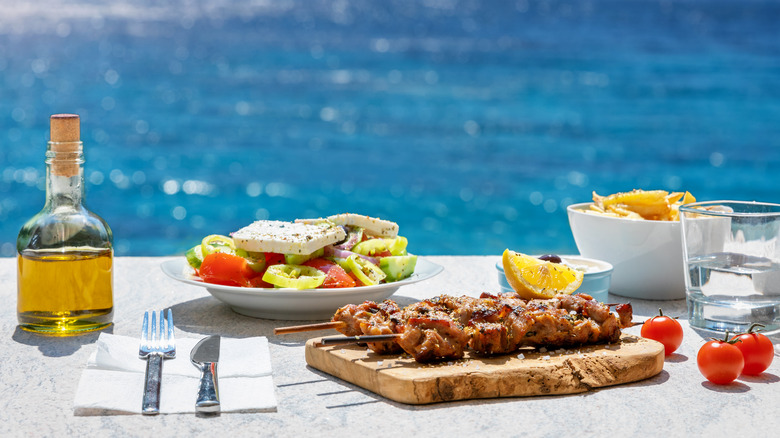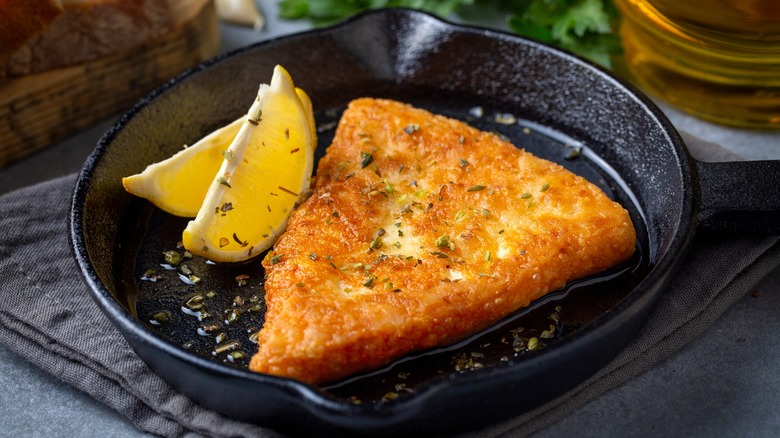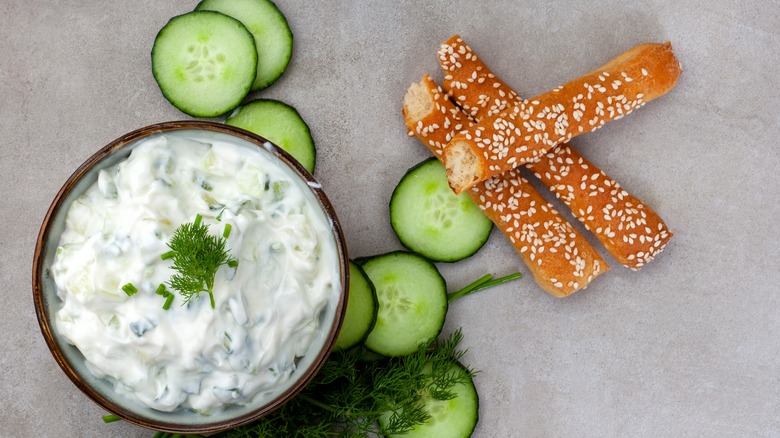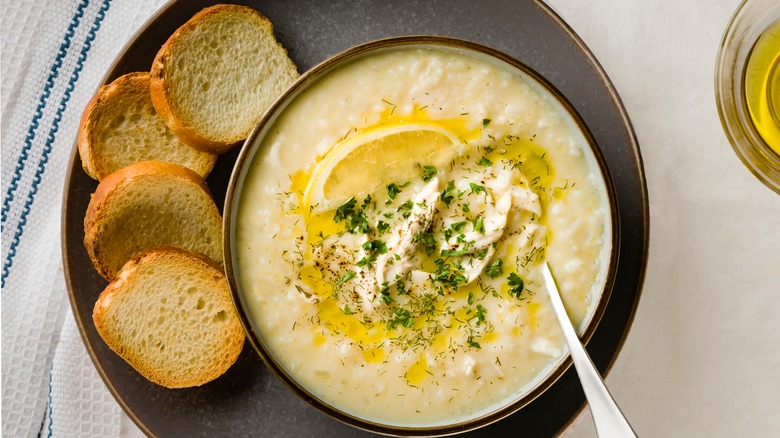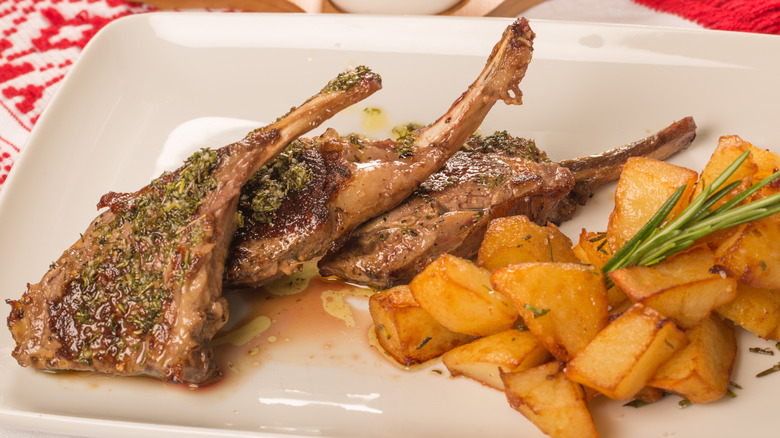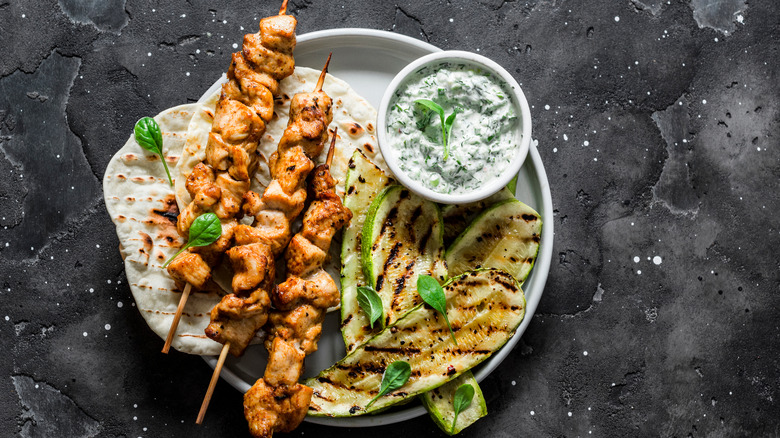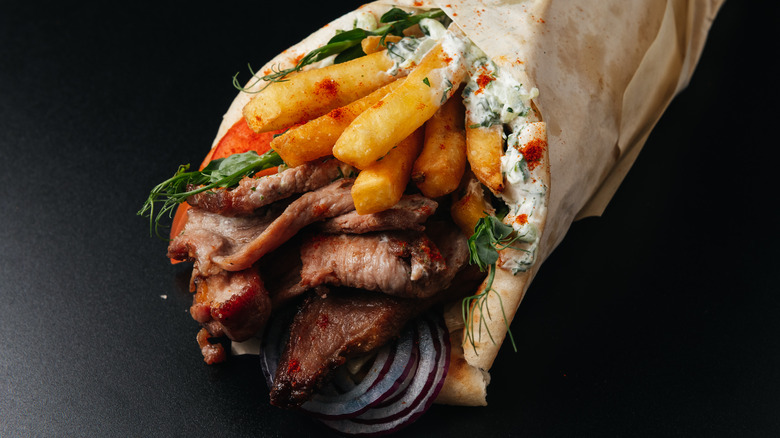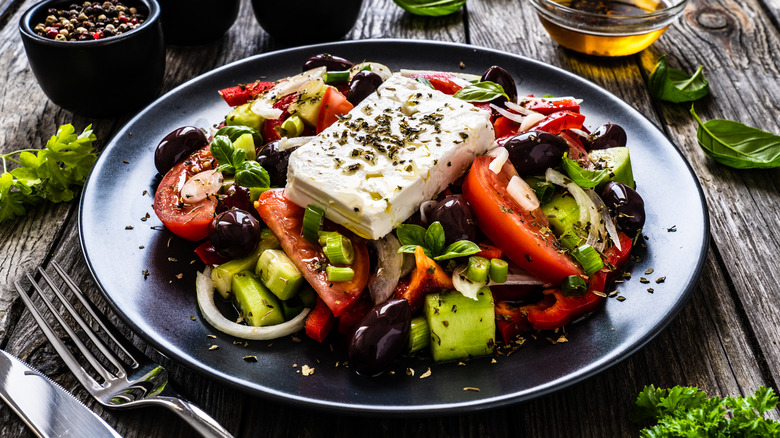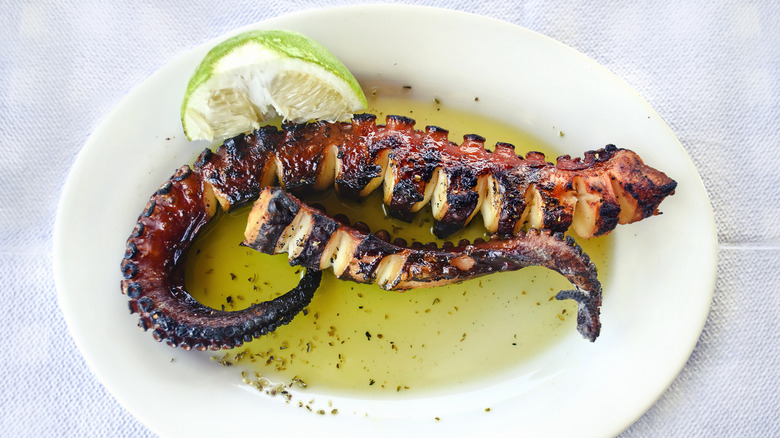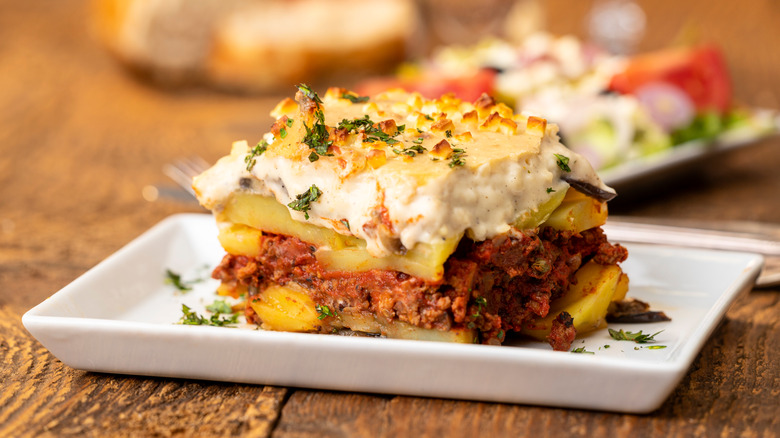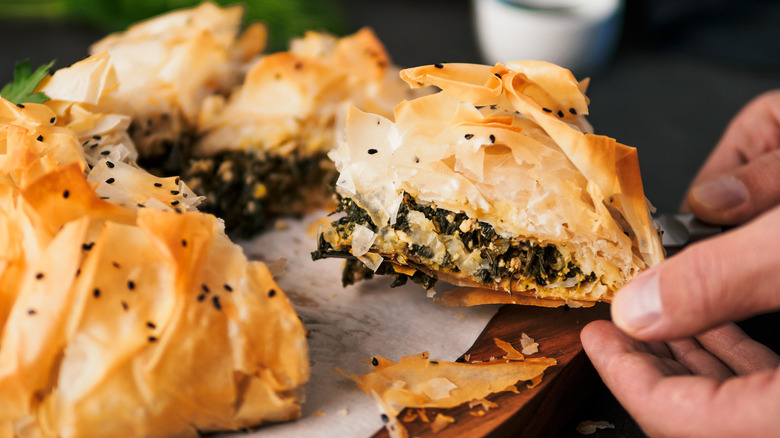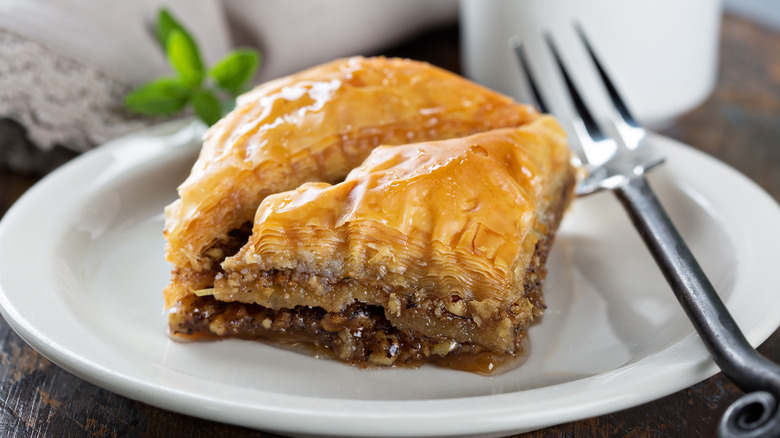14 Foods You Should Be Ordering At Greek Restaurants
Greek cuisine is an international favorite that often finds its place on the list of best national gastronomies, and it is easy to figure out why it became so popular. Greek dishes are simple, unpretentious, and the closest to home cooking. This is a cuisine that does not call for overpowering spices or unusual ingredients. Instead, the entire culinary narrative is based on the idea of deriving as much flavor from the ingredients as possible and then boosting it with subtle additions, such as olive oil, lemon juice, and aromatic Mediterranean herbs. Although simplicity is one of the main features of Greek cuisine, it is also loved for its diversity. It is equally known for its meat dishes, abundant seafood, and many vegetable-forward meals.
Since Greek cuisine is so easy to transplant elsewhere, it found a place in numerous corners of the world, and these days you probably won't have to spend much time to find one Greek-inspired tavern nearby. If you have not yet discovered your favorite Greek dish, it's best to familiarize yourself with the best items to order at a Greek restaurant. Of course, drinks also form the identity of Greek cuisine and complement the entire dining experience at Greek restaurants.
1. Saganaki is the perfect fried appetizer
Any Greek meal should start with an appetizer, and saganaki is one of the best choices if you are craving something warm and filling. Essentially, saganaki refers to the small frying pan with handles in which all saganaki dishes are made and served. As the pan is small, these specialties are traditionally enjoyed as appetizers or small bites. It can sometimes be made with seafood; mussels and shrimps are standard options, but you will most likely see it listed as fried cheese saganaki.
The dish includes a whole block of cheese, typically firm varieties such as kasseri or kefalotyri, dusted in flour and seared until it attains a golden, crisp crust. Saganaki should be served immediately, as the crust is still warm and crisp, and the cheese stays warm and slightly gooey. It can be served with other familiar appetizers, such as pita bread and various dips, but you can also have it on its own. For the ultimate experience, squeeze some lemon over the cheese for a citrusy kick. Greek restaurants in the U.S. sometimes finish off saganaki by flambéing it with ouzo, which is a traditional anise-flavored spirit from Greece.
2. A selection of traditional dips is a great option
If having a hunk of cheese for a starter may seem too much, and you would like something lighter and more refreshing, you can order a plate of Greek meze that often includes a selection of classic Greek dips served with fresh pita bread.
Tzatziki is one of the typical options you will see on the meze platter. This zesty sauce combines yogurt, fresh cucumbers, and dill, and you will often see it served as a dipping sauce with meat-based main courses. Another favorite is melitzanosalata, an eggplant dip that incorporates mashed roasted eggplant, olive oil, garlic, and lemon juice, resulting in a chunky sauce similar to baba ghanoush. Taramosalata (made with fish roe) is another interesting option worth trying if you see it on the menu.
Greek pita bread that is typically served as a part of meze resembles typical European and Middle Eastern flatbreads, but it is usually slightly thicker and does not have a hollowed center. You will usually see it sliced in quarters, which makes it ideal for dipping in the sauces. Meze, along with bread and dips, sometimes includes olives, salads, and some warm dishes. Traditionally, you would sip on ouzo or raki while you enjoy your meze platter.
3. Avgolemono soup is a heartier appetizer option
Avgolemono is a perfect choice if you are craving something hearty and warm to start your Greek feast. In its base form, avgolemono is a sauce that combines flavorful broth with lemon and beaten eggs, but you will usually find the combination whipped up in a warm, nourishing soup. Though avgolemono originates from Jewish culinary tradition, it has completely integrated into Greek cuisine, and it is now considered a traditional dish. Avgolemono has a versatile use and often accompanies meat or vegetable-based dishes, but in the U.S., avgolemono is mainly featured on the menu as a soup.
This unusual combination results in a comforting dish that gets the creaminess from the eggs and a subtle tang from the lemon juice. The broth is usually enriched with rice or orzo, which are tiny pasta specks that resemble rice kernels. Some less traditional versions will amp up the protein with the addition of chicken meat. Avgolemono can be a great introduction to a traditional Greek meal, regardless of what you are having for the main course.
4. Snack on dolmades
Dolma or dolmades is a name that is used to refer to a variety of filled dishes that are found in Balkan and Middle Eastern cuisine. The Greek version of dolmades consists of rolled vine leaves that are usually stuffed with a mixture of rice and spices, but in other regions, you will find onions, zucchinis, or peppers filled with a variety of meat or vegetable-based fillings. The filling for Greek dolmadeis usually a mixture of rice, onion, olive oil, and various herbs.
The rolls are neatly rolled and packed, cooked in a tangy sauce, and usually chilled before they are served. Dolmades are mostly offered and enjoyed as an appetizer. They could be an excellent partner to other meze-style dishes, especially with some classic Greek dips or with main courses, but feel free to eat them on their own, preferably drizzled with lemon and served with a warm, house-made pita on the side. You can also find meat-based dolmades, though they are slightly less common on restaurant menus. These will usually be eaten warm, served with either a zesty yogurt sauce or a creamy avgolemono-style dressing.
5. Lamb is always a good idea
Greeks are big lamb lovers, and you will often find at least one lamb-based dish at a traditional Greek restaurant. Greek cuisine has several different renditions of lamb. It is used for roasts and to make meat sauces or souvlaki, but perhaps the best version comes in the form of marinated and grilled lamb chops that you will see labeled as paidakia.
The chops are usually marinated in a combination of olive oil, lemon juice, and Mediterranean herbs and grilled over charcoal to get that distinctive smoky kick. These juicy cutlets may be small, but they pack a ton of flavor and do not call for elaborate side dishes. Roasted vegetables, potatoes, salads, or just pita bread on the side are all lovely accompaniments for this dish. In order to make the perfect paidakia, the quality of the meat should be outstanding.
Lamb is the star of this dish, which is why it's important to ensure you order this item at reliable and trusted Greek tavernas. It is worth mentioning that the typical Easter tradition in Greece involves roasting a whole lamb on a spit, but this is something you will rarely see featured on a standard menu at a Greek restaurant.
6. Souvlaki is a classic
Souvlaki is one of the most common meat dishes you will find on traditional Greek menus. It's an item that illustrates the entire philosophy of Greek cooking based on the idea that the dishes should not be overly complicated but still have a fantastic flavor. Essentially, souvlaki consists of meat skewers that are grilled over charcoal. The meat will typically be divided into bite-size chunks and then neatly assembled on a skewer. Pork and chicken are the most common options, but beef or lamb souvlaki are not unusual.
The best thing about souvlaki is that it goes well with all Greek side dishes. Souvlaki is typically served with house-made pita and a dollop of tzatziki, but feel free to pair them with any classic Greek dips or fresh salads. As souvlaki is so easy and quick to prepare, you can be sure that the order will be served straight off the grill.
7. Gyros make for a great quick lunch
Gyros, along with souvlaki, are straightforward classics that are integral to traditional, everyday Greek cuisine. Gyros typically consist of pita bread that acts as a wrap and is filled with thin strips of grilled meat and sliced veggies, usually tomatoes, lettuce, and sliced onion. Greek gyros often include a slightly unconventional sandwich addition: A handful of fresh fries. The whole combination will be doused in a creamy tzatziki sauce.
The meat used in gyros is not grilled the traditional way. The technique calls for a stack of seasoned meat assembled on a vertical spit that slowly turns in front of the grill. The meat is then shaved from the spit into thin strips that are then tucked inside the bread. Gyros grills are common sights in Greece, but as this sandwich has become an internationally loved specialty, you will easily find these bulky grills in most corners of the world. Greek gyros can be made with pork, beef, lamb, or chicken. On rare occasions, you can even find some mixed meat varieties.
8. Greek salad is a must
Greek salad does not need much introduction, but it does require some explanation. The Greek salad we usually see on menus is originally known as horiatiki, a Greek word that translates to village. The original name suggests that this now world-famous salad got its start as a simple and unpretentious rustic dish that made use of ingredients that were available and probably plentiful. This classic does not call for extravagant ingredients but creates an amazingly refreshing dish. The base of every Greek salad is made with cucumber chunks, sliced onion, and diced tomatoes. Red onion is the preferred choice as it is more subtle in its raw form.
Typically, the salad will include some olives (preferably the legendary Greek kalamata variety). The salad is typically topped with a thick block of feta cheese and a generous sprinkle of oregano. The salad is usually dressed with plenty of olive oil and often a splash of vinegar. Additional ingredients might be a signal that the restaurant does not serve the most traditional version of the salad. Greek salad can make an excellent appetizer, but you can also serve it with virtually any main course dish from a typical Greek menu. The ingredients inside the classic version are very seasonal, making it your go-to option for the perfect summer salad.
9. Grilled octopus is a great seafood option
Though meat takes center stage in Greek cuisine, this Mediterranean country is surrounded by sea, so naturally, seafood makes up a large portion of the Greek diet. Fish is often found on the menus, but grilled octopus is perhaps the biggest star of the seafood section. This simple and unpretentious dish consists of octopus tentacles that are grilled until they attain some char and become tender. Ideally, octopus is grilled over charcoal, so it usually attains some smoky notes that work so well with the buttery octopus meat.
Often, the tentacles are served doused in a generous amount of olive oil. Smaller portions are usually offered as an appetizer, making this excellent meze dish when it's paired with dips or other seafood specials. Octopus is also a standard main course, usually served with various side dishes. Either way, grilled octopus is the perfect choice if you want to familiarize yourself with Greek-style seafood.
10. Moussaka is the ideal go-to order
Moussaka is one of the most famous Greek dishes. Because of its popularity, it is a staple on the menus of traditional Greek restaurants. It's probably one of the most reliable restaurant options, as any decent restaurant will try to dish out a consistently good version of this classic. Traditionally, moussaka is a layered dish made with a potato or eggplant base. Sometimes, both options will be used in the same dish. Additionally, the eggplant is typically topped with potatoes and a hearty meat ragù, usually made with beef or lamb. The whole thing is topped with a generous amount of creamy bechamel.
Moussaka is not one of the dishes that is derived from ancient Greek cuisine. Its origin is much more recent, as it is estimated that it appeared sometime in the 20th century. Moussaka is not exclusive to Greece. You will find similar dishes all across the neighboring region and the Middle East, but Greece promoted this classic as its national specialty. As such, it would be a mistake not to order it if you are up for a filling and hearty Greek meal.
11. Don't skip savory Greek pies
You probably know that the word pita describes the traditional Greek flatbread, but the term is also used to create compound expressions for numerous sweet or savory pies. These include melitzanopita (eggplant pie) and prasopita (leek pie). Sweet versions will find their place in the dessert section, but the savory pies are the true winners. You'll often see them featured as appetizers.
The two most common versions are the spinach-based spanakopita and the cheese version listed as tiropita. Most of these pies are made with layers of phyllo pastry, creating a crispy shell that holds everything together, but versions that don't contain phyllo are also common. These filling pies are quite versatile and are available in many forms and sizes, but you will mostly see them in large tray pies or small, neatly packed pockets. Savory Greek pies can be enjoyed as appetizers, but larger portions are a great option for a light restaurant lunch.
12. Baklava is the perfect ending to a Greek meal
Baklava is a layered dessert consisting of numerous sheets of butter-coated phyllo pastry intertwined with layers of chopped nuts. It's doused in sugar or honey syrup. Though the origin of baklava is mainly associated with Turkey.This scrumptious dessert is an international treat that wears many hats and finds its place in several national gastronomies. Despite its controversial origin, it is one of the most famous desserts in Greece, and it's a staple at traditional Greek restaurants.
Greek baklava is mainly made with walnuts, but almond or pistachio-based versions are also standard. Unlike other varieties, the Greek version generally uses a honey-based syrup flavored with cinnamon and cloves. The result is a juicy, nutty dessert that stays tender and moist in the center but usually has a flaky and crispy top. Baklava is rich and potent, and it's an ideal ending to a traditional Greek meal.
13. Pair your desserts with Greek coffee
You may be familiar with Greek spirits and exceptional wines, but you should order traditional Greek coffee if you want to end your meal with a caffeinated, non-alcoholic option. This potent brew goes perfectly with dessert. Greek coffee is quite distinctive from classic brewed coffee or espresso. It is, however, similar to coffee types that you will find in the Middle East, Cyprus, and many Balkan countries.
This coffee style is made with finely ground coffee and calls for a special brewing vessel with a wide bottom and a narrow top. The coffee is added directly to boiling water, and the mix is rested so the grounds settle at the bottom. It is then served in small, espresso-like cups. Greek coffee should be richly flavored, dark, thick, and creamy, topped with a light layer of foam. The flavor is slightly bitter, but you can sweeten the coffee to your taste. If you pair it with a dessert such as a baklava, try avoiding sugar, as the sweetness from the cake will beautifully complement the bitterness.
14. Try some traditional Greek wines and spirits
Greek drinks would be incomplete without some legendary Greek drinks. A glass of ouzo is the most traditional choice. This anise-flavored spirit is essentially an all-rounder you can pair with virtually any Greek meal or simply serve as an aperitif or a digestif. Ouzo is usually mixed with water to attain that distinctively milky look. You should not gulp it all at once but slowly sip it to savor its unique flavor. If you are not a fan of anise, tsipouro is another excellent option for meze dishes. Tsipouro is a grape spirit that's usually available in a non-flavored version.
Apart from spirits, Greece is well-known for its wines and an ancient wine-making tradition, considered one of the oldest in the world. Unsurprisingly, the country is rich in unique varietals, but Assyrtiko is perhaps the strongest contender for the best Greek wine. The wines made from assyrtiko are usually bright, zesty, and mineral, making them an ideal accompaniment to most Greek dishes. Arguably, the most promising labels come from Santorini (where the grape originated), so make sure to get the best option if it's available.
